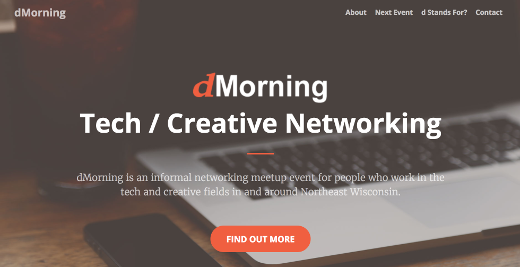Wisconsin Roundabouts To A Native Massachusetts Rotary Driver
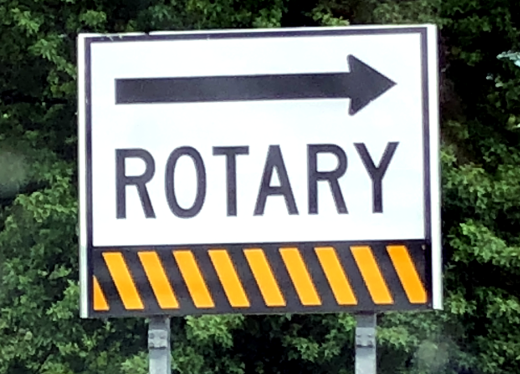
On a recent trip back to the Boston area I rented a car for the weekend, and as I slipped behind the wheel I also slipped back into Boston driving mode. Or at least as much as I could, as living in the Midwest for the last 15 years has dulled some of my Massachusetts driving edge. As I positioned my hands on the wheel, with my thumb on the horn, I hit the winding roads which were originally blazon by cattle, wagons and marching soldiers. And along the way, I went through a few rotaries.
Rotaries are what they (I?) call out East what I see as a growing occurrence locally here in Northeast Wisconsin, the roundabout. Where they are not anywhere a new invention, and certainly not one solely in the US, roundabouts are being put into place in the area that I now call home, and have been put into place, as the next coming of driving. And they are still going up on roads and intersections.
For someone who has been driving through this type of traffic pattern since I have been driving, I want to share my insights on them from Right to Mid Coast, and how I don’t see what the big deal is.
You Spin Me Right Round, Baby
My definition of a rotary – or roundabout – is a way for traffic to flow through an intersection of 2 or more streets without the need for a traffic light. Cars will approach the rotary, pause for incoming traffic, enter the rotary going around to the right of the center of the rotary, then exit it at the appropriate street. It of course requires everyone to obey these simple rules, and nobody or their cars gets hurt. Simple enough, right?
Growing up in Massachusetts, where most cities and towns predate most of the states in the US, these rotaries have always been there. Sure, some may have been added over time, but the convergence around a circle to get to the street you are heading was nothing new. Fast forward to the times I have been to Wisconsin prior to moving here last year, I have seen roundabouts being created in certainly the dozens over the years, and I hate to say it but to my amusement as well.
My Rotaries Are Not These Roundabouts
The above photo is from a rotary just north of Boston. It a more modern and much smaller sign, as traditional rotary signs were much wider – sometimes 2 or 3 times the width of this one – and much lower to the ground. In other words, when you approached a rotary, you wouldn’t be able to miss it. There also may be a Yield sign as you approach the rotary, but other than that you won’t see any other special road markings or signage that you were entering or going through a rotary in the Bay State. Why? I don’t recall the specific from the road test manual I studied in the early 1980’s.
Moving about 1,500 miles west, you find the rotaries in Wisconsin. Honestly, they are beautiful, and that goes beyond the landscaping. Overhead and side signage greet you as you approach the roundabout. The markings on the signs correspond to the markings on the road, as the road can flare into 2 or 3 lanes, depending on the intersection, on the options you have for going through the roundabout. These lanes continue through the roundabout until you exit it.
As you exit a roundabout, don’t be surprised if there is another one right next to it. Seriously. A whole, completely new roundabout, covering another set of streets including the one you just came in from the last roundabout. Though I don’t have insight into what the roads looked like previously, likely there was another traffic light, and if you are replacing one, then replace them all? Another scenario is you will have a roundabout at each side of a bridge by a highway exit. This “phenomenon” of adjacent roundabouts is something I still can’t get my head around fully, but of course manage to go through just fine.
Since I have moved here I have observed first hand and thru the media as new roundabouts open. One in particular was added at an intersection of 2 streets that had a high accident volume, presuming the roundabout would lessen or eliminate these accidents. However after it opened accidents continued and I personally observed many close calls going through it. Some say it is due to people’s lack of experience with roundabouts and I would agree with that. Though with the signage and lane markings, what to do is almost spoon-fed to you as you enter.
These Roundabouts Are Not My Hometown Rotary
As you may have sensed from the beginning of this, I laugh a bit about the roundabouts here in Northeast Wisconsin. But I have good reason. Many of these roundabouts are at the intersection of 2 or maybe 3 roads. As you approach a roundabout, even with the well-groomed circular island in the middle, you have a clear view of most all of the traffic that is approaching or coming through the roundabout.
It just so happened I grew up in East Longmeadow, Massachusetts, a suburb of Springfield. Where Springfield is the home of the US’s first armory and basketball, East Longmeadow is home to the wicked fast XLERATOR hand dryer and a rotary that ties together 7 streets. Yes, seven. Maple, Shaker, Prospect, Somers, Pleasant, Elm and North Main. You can see it for yourself on Google Maps if you don’t believe me. Seven streets was enough to get it listed in Ripley’s Believe It or Not, and interestingly the submission was by the builder of most of the homes in the town.
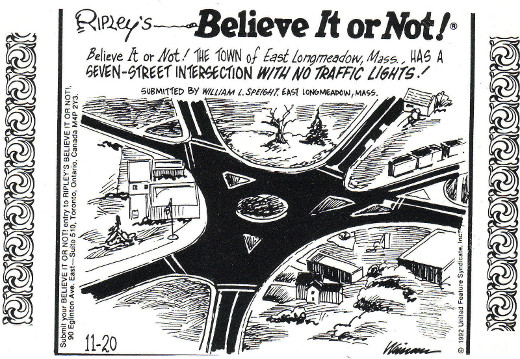
So when you see that car with the Patriots sticker on the back and Wisconsin license plates proceeding through the roundabout with confidence, it didn’t come overnight. When your first driving lesson started on Maple Street and you were headed into the East Longmeadow rotary, you best learn fast.
Deconstructing Roundabouts
The potential for less accidents, faster moving traffic and better fuel economy make roundabouts – and rotaries – a good choice for road improvements. In the short term as roundabout are built there will be both learning and cost curves – the more times you use a roundabout, the better experienced you are with them. But these come at a cost – I saw a new roundabout was well over US$1Million. Hopefully by the time people are used to driving through them the investments by communities in them will have at least broken even.
This is from The Hot Iron, a journal on business and technology by Mike Maddaloni.
Did you enjoy this? Subscribe to The Hot Iron by RSS/XML feed or Read by Email.
Strategize • Technology • (0) Comments • Permalink
The Secret Life Of Old iPhones
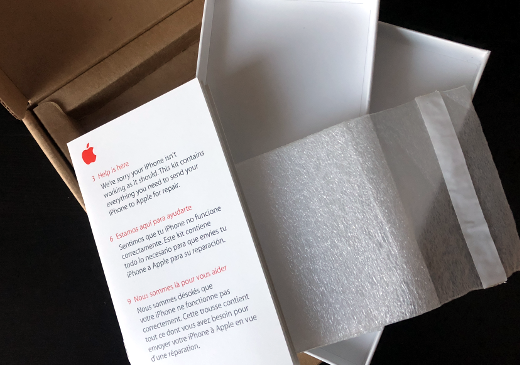
When the spotlight was shown on Apple’s “feature” to reduce the power of later model iPhones to compensate for degrading batteries without the owner’s knowledge, the tech giant’s remedy for this, accompanied by an apology, was to reduce the price they charge for a replacement battery from US$79 to US$29. A future upgrade to the iOS operating system will allow owners to disable this “feature” which should close the loop on this issue.
Like any action, there is always a reaction, or maybe 2 or several. In this case, Apple’s reputation has lost a little more of its luster, continuing what many have seen in a decline of their public perception since the death of founder Steve Jobs. No iPhone owner will be surprised if they receive an email or letter in coming months about a class-action lawsuit against Apple. I would add to this an observation I made when I was packaging up and sending in 2 iPhones for new batteries – a new life for otherwise “outdated” devices that may impact their future sales.
Reasons for Upgrade
Whether it’s a car, house, clothing or a smartphone, we all have reasons for upgrading to a newer model when available. On one end of the spectrum are more functional reasons, such as the “need” for new features – in the case of a smartphone, a faster processor or more memory. On the other end are reasons more for “form” or simply the desire to have the latest and greatest of whatever it is. Where I know people in the latter category, I know more that, especially with the rising cost of these devices, are sticking with older models.
Typically, these decisions were merely personal. With the lower battery cost, economics comes into play. By getting a new battery for around $30, you are in essence getting a new, older model smartphone. If you still want to upgrade to a new model, by making a small investment you can conceivably have a more valuable older model device, or one you can pass along to be used by someone else as if it were new.
As the ability to buy a used or new, older model device already exists, the aftermarket for iPhones will now expand with the opportunity for additional devices to be available in it. Or in my case, the demand for buying a new or additional devices has decreased with additional, well-suited devices, available to be reused for a lower cost.
Digital Hand-Me-Downs
Recently I got a new iPhone 8 mainly for the memory, as my iPhone 6’s paltry 16 GB was forcing me to delete apps just to take a few videos of a few minutes in length. And of course, the battery was spent to the point where I had to charge it several times a day, not to mention carrying a spare battery with me all the time. Despite these drawbacks of the 6, it was in great physical condition, and would be well suited for someone else to use.
Such a reuse is going to happen, as the device will be used by a family member who is upgrading from a flip-phone. I have sent it and paid the approximately $30 (I believe there was tax on top of it), once I get the phone back I will set it up for this family member as their more-than-perfect entry into the world of smartphones. Other older models of iPhones are already in use in my family, as my kids use them as WiFi devices and without a SIM card, after I followed what I shared before on how to best setup an iPhone for this purpose.
With the number of iPhones sold over time, there’s a demand for the new batteries. I personally ordered and sent in 2 iPhones, a 6 and a 6S, as I no longer live within walking distance of an Apple Store. Where I sent in the 6 before the 6S, the 6S came back within 3 days. Looking into it, there is a shortage of 6 and 6+ batteries. Apple’s Web site gives me no indication my replacement is pending for this reason though. Once again, a spotlight is being shone on Apple that they have to react to.
Deconstructing a New Life for old iPhones
How will this new life for these iPhones impact the market for new ones from Apple? It’s hard to say exactly. Technology today is made to be disposable, as repair costs will typically cost more than buying a new item. However, with the cost of the new iPhone X at US$999 or even the new iPhone 8 at US$699, paying thirty bucks for a new battery is almost a no-brainer, whether you personally need the device or are looking to sell or hand it off to someone else.
This is from The Hot Iron, a journal on business and technology by Mike Maddaloni.
Did you enjoy this? Subscribe to The Hot Iron by RSS/XML feed or Read by Email.
Mobile Technology • Strategize • Technology • (2) Comments • Permalink
7 Blog Topics Written in 2007 That Are Still Relevant Today

Back when this little blog from which you are reading this post turned 10 a year ago, I started thinking about what I have written over these years, especially that first year. As a new writer at a time when social media was still in its infancy, I wondered what topics or “hot irons” I decided to “strike” a decade ago. This led me to pour through the archives of The Hot Iron and reading what I wrote in 2007.
As it turns out it was a mix, from well thought-out articles to short pieces that would have probably been social media posts had those networks been more prevalent. In all, I made 236 posts over 365 days. Where some in hindsight I probably would have written differently or perhaps not at all, there were many I read which pleased me that I shared my thoughts with my new audience. Overall, there were 7 topics or themes which I covered back then that I feel are still relevant today, and I would like to share them with you on a short trip down memory lane.
1. Domain Names – As the genesis of this blog was from, and was to support, my former Web consulting business, coupled with the fact I felt many people knew very little about domain names, I wrote several articles on domain names that first year. Over the years, I continued to write even more about domain names because, even after over 2 decades of they being commercially available to the public, I felt then – and still today – domain names are not well understood.
Among the posts included Be the master of your own domain (name) on registering domain names in general, Own the Domain Name for Your Name to encourage my readers to register the domain name for their own name, Know Who Manages Your Domain Name as many register domains but will forget where they did so, Beware Unsolicited Invoices for Your Domain Name on deceptive practices for selling registration and Web-related services by sending what looks to be a legitimate invoice, Domain Name Owners Not Who You Would Think on missed opportunities to register domain names and Observations of German Domain Names about how this American saw domain names in action in Germany.
Ten years later, I think all of these posts and what they discuss are very relevant. As I work with firms and talk with people about domain names today, much of what I wrote could inform them, and possibly save them time, money and headaches.
2. Networking – I never took a class on networking in college or afterwards, namely for until recently there was never such a thing. What I learned about meeting and connecting with people I learned literally on the job, through trial and many errors, as well as successes. Perhaps I should have developed a class on it (or perhaps I still should?) but as a close second I wrote about several aspects of it.
Posts on networking I wrote were My Networking Event Checklist about how I prepare for networking events, Community building is up to ALL of us on why I network, Nametags Essential for Networking on why there’s nothing wrong with wearing nametags and Time to Write The Note Cards on following up with people after meeting them.
In several of these posts I mention Jason Jacobsohn, someone whom I met online then in real life after following his blog Networking Insight, which today is still a vibrant resource on the art and science of networking. Even though I no longer have my own business, the need for connecting with others still exists, and is the driver for why I recently started dMorning.
3. Opportunity Cost – Shortly after starting my business I learned quickly about trade-offs, and when you do something it often doesn’t allow you to do another. Through this balancing act I had a flashback to college and penned All I remember from Economics 101 - Opportunity Cost. Where opportunity cost has come into play for much of my life, as it does for most of us, it was intensified when I was the boss and sole staff of my business. This discipline was an on-going effort, and helped by seeking the counsel of other small business. As time went on, and jobs replaced my business and my family grew, recognizing the opportunity cost of one decision over another became even more important in my life.
4. Customer Service – The challenges I faced as a small business owner, I learned, were not that much different than those faced by much larger organizations. However I was always stunned how an entity with many, many more employees could still miss the mark on things that, to me, were obvious. I thought that then, and sadly I still do today.
In 2007, JetBlue Airlines had an incident where passengers were stranded on an airplane. During a discussion on this with a colleague, an idea popped into my mind, which I wrote in A Free Idea for David Neeleman, an open letter to Neeleman, the founder and then CEO of the airlines, and I offered to him this idea. I have no idea if he, or any other airline CEO, ever read it. But by hearing the customer services disasters airlines still experience in 2017, my guess is not.
5. Accessbility – My first exposure to Web site accessibility came when I helped a friend who is legally blind with his PC. This was a rare case of providing tech support to a friend that had a benefit – learning the world of accessibility tools. I learned about JAWS, a leading “screen reader” which literally reads aloud what is appearing on the screen – be it icons, a menu or what is in a Web browser. Where this was great to be exposed to, I also learned of the challenges he faced with using the Web – most Web sites are not designed or programmed to make it easy for someone who is visually impaired to navigate and use them.
I wrote specifically about my experiences with my friend’s computer in a post called Unintentional Unusability where I barely scratched the surface on many areas, and mentioned how a design decision for this very blog was based on this experience. It was because of this I was eager to adopt the now-defunct service Odiogo which I went into detail in the post Hear My Blog Posts.
Today Web site accessibility is something I am still concerned with and work to overcome. As technology and their tools continue to advance in some areas, they continue to lack in this particular area.
6. Giving Back – As giving back to the community has always been a big part of my life, I made sure to include it when I came up with a list of “gift ideas” which were simply promotions of my clients. Where the idea was to send business their way so they would ideally send more business mine, I wasn’t betting the farm on this tactic, and it was probably good that I didn’t either!
Among the posts I wrote was one that would only send a good feeling back to me, and needed resources to a great organization. In Gift Idea – Help Young People by Donating to YouthBuild Boston I asked people to make a donation to YouthBuild Boston, a non-profit in Boston that I have supported for years, and at the time were a pro-bono client of mine. YouthBuild Boston works with young people to help them be self-sustaining. They offer skills training in the construction trades, as well as the support they need to succeed. They are an amazing organization, and one that is well run as well. If you haven’t made all of your year-end donations, they are a highly worthy recipient today as they were then.
7. Health – When I started my blog, my business was home-based and my office was in the den. A decade later, I am once again working from home, this time for an organization. I have a nice short commute, but it is a commute where I walk and sit, and sit for a while. When I came upon the post I wrote Walk to Work Even If You Work From Home, it reminded me that I need to get off my butt more during the workday, even when the weather is in the single-digits as it is as I write this.
Deconstructing What I Wrote 10 Years Ago
As time goes by, some things remain a constant, which I found in re-reading what I wrote over a decade ago. Many issues and thoughts I had then are top of mind today, and I this to the fact they are part of who I am and what I believe in. My quest for people to learn, understand and be able to use technology in a calm, connected, active and charitable world is a journey I am still on today. As I continue my blog into its second decade, topics I will write about will likely include those mentioned above.
This is from The Hot Iron, a journal on business and technology by Mike Maddaloni.
Did you enjoy this? Subscribe to The Hot Iron by RSS/XML feed or Read by Email.
Blogging • Business • Strategize • Technology • (0) Comments • Permalink
Announcing dMorning Tech Creative Networking In Northeast Wisconsin
With great anticipation I am pleased to announce a networking event for people who work in the tech and creative fields in Northeast Wisconsin. Introducing dMorning.
So what is dMorning?
The idea behind dMorning is relatively simple - informal networking before the busy workday starts, with no set rules and no agenda. Since I moved to the Fox Valley of Wisconsin this past summer, I have been looking for something like this, as I work in the Web and I am looking to meet people who work in similar fields in my new home area.
In the past I have hosted a variety of meetups where I used to live in Chicago – some specific and some general – and I have found the latter to be more interesting. A casual gathering of people to talk about what they are working on, sharing stories and bouncing ideas off each other… this is something I have wanted to restart for a while, and why not here? My plan is for this to be a monthly event.
The first dMorning will be on Friday, November 17 at 7:30 am at All Seasons Coffeehouse in Appleton, which is conveniently located off I-41 at Wisconsin Avenue. I only say it goes until 9:30 am as that is likely as long as I will be there. There is no cost for dMorning, you only have to pay for any beverages or food you purchase from this locally-owned business.
What’s in a name?
You may be wondering about the name, dMorning. As I sought out a name for this, I didn’t want to pick something limiting. On the Web site at dMorning.com there are some ideas of what the “d” could stand for.
Hope to see you there!
This is from The Hot Iron, a journal on business and technology by Mike Maddaloni.
Did you enjoy this? Subscribe to The Hot Iron by RSS/XML feed or Read by Email.
Announcements • Business • Mobile Technology • Technology • Thrive • Web Design • Web Development • (0) Comments • Permalink
My Guest Lecture On Consulting at University of Wisconsin – Oshkosh
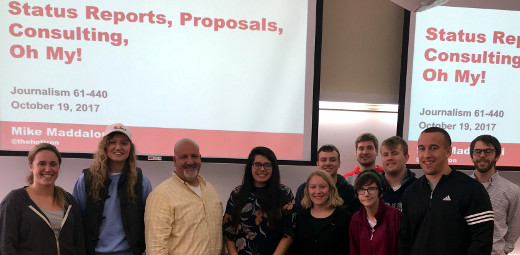
Last week I had the honor to guest lecture to students at the University of Wisconsin – Oshkosh (UWO) on the topic of consulting. As the students are working on group projects where they consult to organizations on the Web and social media, I was thrilled to be asked to share my experiences, stories and advice on consulting and working in technology.
The class, Application of New & Emerging Media, is taught by Dr. Sara Steffes Hansen, associate professor and chair of the Department of Journalism at UWO. The class is a required course for the Interactive Web Management (IWM) major, and also part of the curriculum for journalism and public relations majors. The interdisciplinary IWM program combines journalism, business and computer science courses to prepare students for digital careers, where all of these skills are vital.
With 10 students in the class, it was a good setting to talk on this topic of consulting, as well as the upcoming deliverables for their project, including an interim status report and a proposal to the client at the conclusion of the semester. I talked about the commonly-accepted description and roles of consulting, my take on it, as well as real-life examples (with client names properly masked) of positive and not-so-positive experiences throughout my career which spans now a quarter-century. As nobody nodded-off in class and the questions posed by the students were of a high caliber, I am hoping they got as much out of the time as I did.
Dr. Hansen said the students handed in their status reports this week, and discussed the aspects of customer service and risk. She added, "the students applied those real-world examples and consulting essentials from your presentation to their own communication efforts with clients. They could articulate the management of risk for the unknowns in their projects, which is a part of any Web, eCommerce or social media endeavor. It was nice to see the students enjoy their consulting roles in this discussion."
This is the second time I have given a guest lecture in one of Dr. Hansen’s classes. Two years ago I spoke to her class, incidentally a pre-requisite of this one, on the topic of blogging. Where the last time I remotely spoke to the students using the Personify technology and a 3D Web camera, this time I was in person in the classroom, the method I prefer much better.
I have posted the slides from the lecture on SlideShare, and you can view them embedded below or view them at this link on SlideShare’s site. On slide 11, I selected 3 famous people to help describe proposals – can you guess why I chose them?
(photo credit – Dr. Sara Steffes Hansen)
This is from The Hot Iron, a journal on business and technology by Mike Maddaloni.
Did you enjoy this? Subscribe to The Hot Iron by RSS/XML feed or Read by Email.
Announcements • Business • Strategize • Technology • (2) Comments • Permalink



